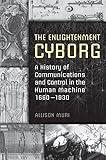The Enlightenment Cyborg : A History of Communications and Control in the Human Machine, 1660-1830 / Allison Muri.
Material type: TextPublisher: Toronto : University of Toronto Press, [2007]Copyright date: ©2007Description: 1 online resource (240 p.)Content type:
TextPublisher: Toronto : University of Toronto Press, [2007]Copyright date: ©2007Description: 1 online resource (240 p.)Content type: - 9780802088505
- 9781442684904
- 303.48/3
- TA167 .M86 2007eb
- online - DeGruyter
| Item type | Current library | Call number | URL | Status | Notes | Barcode | |
|---|---|---|---|---|---|---|---|
 eBook
eBook
|
Biblioteca "Angelicum" Pont. Univ. S.Tommaso d'Aquino Nuvola online | online - DeGruyter (Browse shelf(Opens below)) | Online access | Not for loan (Accesso limitato) | Accesso per gli utenti autorizzati / Access for authorized users | (dgr)9781442684904 |
restricted access online access with authorization star
http://purl.org/coar/access_right/c_16ec
For many cultural theorists, the concept of the cyborg - an organism controlled by mechanic processes - is firmly rooted in the post-modern, post-industrial, post-Enlightenment, post-nature, post-gender, or post-human culture of the late twentieth century. Allison Muri argues, however, that there is a long and rich tradition of art and philosophy that explores the equivalence of human and machine, and that the cybernetic organism as both a literary figure and an anatomical model has, in fact, existed since the Enlightenment.In The Enlightenment Cyborg, Muri presents cultural evidence - in literary, philosophical, scientific, and medical texts - for the existence of mechanically steered, or 'cyber' humans in the works seventeenth- and eighteenth-century thinkers. Muri illustrates how Enlightenment exploration of the notion of the 'man-machine' was inextricably tied to ideas of reproduction, government, individual autonomy, and the soul, demonstrating an early connection between scientific theory and social and political thought. She argues that late twentieth-century social and political movements, such as socialism, feminism, and even conservatism, are thus not unique in their use of the cyborg as a politicized trope.The Enlightenment Cyborg establishes a dialogue between eighteenth-century studies and cyborg art and theory, and makes a significant and original contribution to both of these fields of inquiry.
Mode of access: Internet via World Wide Web.
In English.
Description based on online resource; title from PDF title page (publisher's Web site, viewed 01. Nov 2023)


